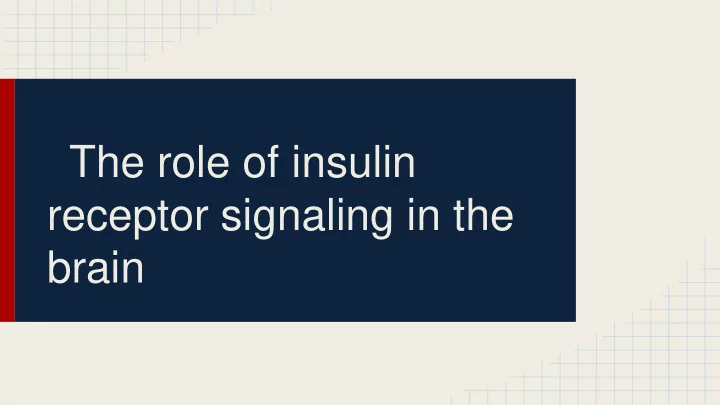

The role of insulin receptor signaling in the brain
Authors Leona Plum, Markus Schubert, Jens C. Bruning
Functions of insulin in the CNS ● Regulates ○ Food intake ○ Sympathetic activity ○ Peripheral insulin action ○ Reproductive endocrinology ○ ATP dependent potassium channels ○ Neuronal apoptosis ○ Phosphorylation of the tau protein ○ Metabolism of amyloid precursor ○ Clearance of beta-amyloid from the brain
Expression of the IR in the CNS and source of cerebral insulin • To initiate signalling in the CNS, insulin must cross the BBB • Margolis et al (1960) o Peripheral infusion of insulin leads to an increase in insulin levels in the CSF o Suggests that insulin CAN cross the BBB • Conditions that affect insulin transport across BBB o Decrease in transport: fasting, obesity, aging, dexamethasone o Increase in transport: diabetes, neonatal period Indicates insulin enters the CNS by crossing BBB through receptor mediated transport mechanism
Brain IRs in the control of energy homeostasis • Insulin injection into the brain o anorexigenic effects/ reduction of body weight o Third Ventricle Administration decreases expression of neuropeptide Y increases expression of corticotropin-releasing hormones increases expression of α -MSH
Brain IRs in the control of energy homeostasis • Niswender et al o PI3K selective inhibition activation • ATP-dependent K+ channels • Figlewicz et al o insulin activates neurons of the mesolimbic dopamine- mediated pathway
Central insulin action and peripheral glucose metabolism • Obci et al o Central administration of insulin increases sensitivity in peripheral tissues o Why is there not increase in glucose uptake in adipose tissue and skeletal muscles? • PI3K • Melanocortin Receptor 4 (MC4R) • Compensatory Responses • Ventromedial Portion of the Hypothalamus (VMH) • Glucose sensitive vs. glucose responsive neurons
Regulation of reproduction: background ● Gonadotropins: ○ Luteinizing hormone (LH) ○ Follicle stimulating hormone (FSH) ● Gonadotropin releasing hormone (GnRH) is secreted by the hypothalamus and promotes the release of LH and FSH by the anterior pituitary. ● In terms of reproduction, LH and FSH act synergistically during menstruation in females to promote ovulation. ● In males FSH and LH stimulates the production of testosterone.
Regulation of reproduction ● This section of the paper explored the role of insulin in the brain ● In an experiment, NIRKO mice--mice with insulin receptor genes knocked out- showed some diet-sensitive obese symptoms, as well as reduced fertility. ○ This was attributed to dysregulation of LH( luteinizing hormone) ● Another experiment looked at mice that lacked IRS -2 (insulin receptor) in their tissues. ○ These mice were obese, and had small non-functioning ovaries, and reduced follicles. ○ Again, this was attributed to the involvement of insulin receptors in proper pituitary development and gonadotrophic action. ● Insulin and insulin-like growth factor-1 (protein with similar structure to insulin that can bind to insulin receptors) stimulates the output of gonadotropin- releasing hormone in the hypothalamus
Role of IR signaling in learning and memory • • In an experiment healthy individuals were administered with insulin under euglycemic hyperinsulinemic conditions- high insulin levels, and normal blood- glucose levels- and they showed an improvement in verbal memory and selective attention • Similarly, intranasal administration of insulin was reported to promote working memory. This exogenous addition of insulin also increased in insulin concentration in CSF without affecting blood glucose levels
Role of IR signaling in learning and memory • In another experiment assessing learning and memory, individuals with type 2 diabetes who were 64 years old or greater were observed to do worse in learning tasks than aged-matched non-diabetic subjects. There was no observed difference in memory impairment for a similar experiment involving younger diabetic individuals. • Relating to neurodegeneration: alzheimer's patients are characterized of having lower cerebrospinal fluid, and higher plasma insulin concentrations, which may be due to some malfunction in insulin uptake in the brain • Administration of insulin to Alzheimer’s patients shows an improvement in memory • Contrary evidence was shown in NIRKO mice, which had shown fairly normal spatial learning in the Morris water maze task. The authors make the claim that IR signaling therefore does not play a primary, or substantial role in memory formation .
Alzheimer’s • A major component of Alzheimer's disease is the hyperphosphorylation of the tau protein. o The tau protein stabilizes microtubules in the CNS, and it's hyperphosphorylation reduces the affinity the protein has for microtubules, and can lead to neurofibrillary tangles that cause cell death.
Role of IR signaling in neurodegenerative diseases • Individuals suffering from Alzheimer's and Parkinson's disease have lower expression of insulin receptors in the CNS. Whether this is a cause, or result of neurodegeneration is unknown, but several experiments show that it may be a risk factor for particular diseases. • Insulin and insulin-like growth factor inhibit the GSK-3 (glycogen synthase kinase-3) active form o GSK-3 beta contributes to the hyperphosphorylation of tau • In NIRKO mice and IRS-2 deficient mice tau hyperphosphorylation was seen
Role of IR signaling in neurodegenerative diseases • IR and IGF1R signals regulate the secretion of amyloid precursor protein APP o Mice were given diet- induced obesity that caused insulin-resistance were observed to have a large increase in beta-amyloid levels • Insulin may be involved with clearing beta amyloid from the brain by inhibiting its breakdown by blocking the insulin-degrading enzyme.
Figure 1
Figure 2
Recommend
More recommend